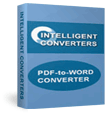Convert PDF documents into Microsoft Word format with PDF to Word
Posted by
Nguyen Chi Cong
Labels:
Home and Education
Unit Price: $19.95
Platform: Windows 95, 98, Me, NT, 2000, XP, 2003, Vista
Version: 2.5
File Size: Full version: 0.77 MB
Publisher: http://www.bluesquad.com
Platform: Windows 95, 98, Me, NT, 2000, XP, 2003, Vista
Version: 2.5
File Size: Full version: 0.77 MB
Publisher: http://www.bluesquad.com
 PDF to Word is a program to convert Adobe PDF documents into Microsoft Word format
PDF to Word is a program to convert Adobe PDF documents into Microsoft Word formatPDF to Word Features
- - Extracts paragraph alignment information
- - Converts images and most of PDF drawing primitives
- - Recognize tables
- - Adobe Acrobat or Reader is NOT required
- - Convert individual pages
- - Command line support
- - Easy-to-use wizard-style interface
- - Full install/uninstall support
NEW! Two optimization modes: preserve text flow or original format:
PDF format is the best choice for high-quality print job with precise format layout and high resolution images. On the other hand Microsoft Word is very powerful document editor that allows to create complex documents with ease. So, Microsoft Word format is ideal for editing purposes or any tasks requiring frequent updates of documents. Because of that difference between Adobe PDF and Microsoft Word formats it is necessary to choose how to optimize PDF to Word conversion: either to preserve text flow or to make the resulting document look most close to the original. PDF to Word converter supports both of these modes in quite intelligent way.
Unlike Microsoft Word, PDF format doesn't have paragraphs, columns and other complex format structures. Each PDF document is a set of text chunks with coordinates that allow high-quality viewing and printing. When user chooses to preserve text flow, PDF to Word recognizes paragraphs, columns and other format structures in the source document and converts them in MS Word format. The converter attempts to keep the original layout using line and character spacing while generating logical structure of PDF file. This trick allows to modify text position on page but it does not destroy paragraphs, columns and tables in the resulting document.
If user chooses to make the resulting document look most close to the original, PDF to Word defines position of text on the page directly using MS Word formatting feature known as "frames" or "boxes". It is an invisible margin that allows to specify exact position for the text enclosed. Even being focused on visual equality of source and destination documents, the converted attempts to make MS Word document easy to edit. Following this way PDF to Word tries to merge as much text into frames as possible unless it destroys the original layout.

Subscribe to:
Post Comments (Atom)


Post a Comment